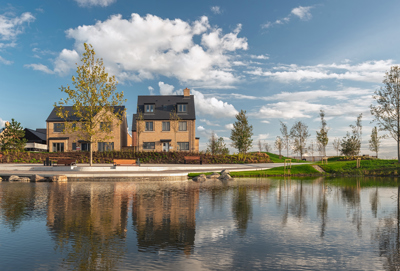You might already know that all homes come with an Energy Performance Certificate (EPC) rating, which gives an indication of their energy performance. But did you know that how those ratings are calculated is changing in Scotland?
Here we explain why the new ratings are coming into effect, and what they mean for your new Cala home.
What is an EPC?
An Energy Performance Certificate. It gives a property an energy efficiency rating from A (most efficient) to G (least efficient).
Why are EPCs needed?
EPC ratings are primarily used by potential homebuyers or renters to quickly see how energy efficient their new home will be, and the impact this could have on their energy bills.
For existing properties, an EPC will be included in the Home Report which is made available to potential buyers as soon as a home is marketed for sale. An EPC also needs to be given to potential renters when the home is marketed for rent. It allows buyers and renters to compare the energy efficiency of different properties easily, to help inform their decision.
Where will I find the EPC rating for a Cala property?
Indicative EPC ratings, known as a Predictive Energy Assessment (PEA), can be found in Cala’s marketing materials, such as our brochure inserts, website image gallery and portal listings. You can also check with a Cala sales representative.
On completion, Cala homeowners will receive an EPC, which will be valid for 10 years
What is changing?
In Scotland EPC ratings are calculated by finding the predicted carbon dioxide emissions per m2 of floor area. An EPC provides a numerical grade, between 1 and 100 and occasionally 120 depending on renewable energy measures and a lettered grade from A to G, with A being the highest.
The way EPCs will be calculated is changing, meaning the rating on some Cala homes may change.
Rest assured, the specification and build standard of your Cala home will not change, it’s just the calculation behind an EPC rating that will.
Why?
The changes are part of the Scottish Government’s fight against climate change, and its strategy for the decarbonisation of energy.
Why? The carbon dioxide emissions from the energy we use in our homes is reducing, as more renewable and low-carbon energy supplies the UK grid. As the carbon factor for electricity has been significantly reduced, and the EPC range of the bandings has remained the same, some buildings can be expected to receive better ratings than before.
To ensure that Scotland continues to make long-term energy efficiency improvements to existing and newly built homes, the EPC bands are changing.
What does this mean for my Cala home?
Most Cala Homes are currently built to an A or B rating, with some in the C category.
Prior to reserving your new Cala home you will receive a PEA; an assessment of the energy efficiency of the home that is yet to be built. This is essentially a prediction of the EPC your home will achieve upon completion. This may have been shared with your mortgage lender and solicitor as part of your mortgage application.
As a result of the changes to EPC calculations, we expect that the rating on some Cala homes may change by a few points. While your new home will not be any less energy efficient, a change in rating may need to be communicated with your mortgage lender and solicitor to ensure it does not impact on your lending. Our sales team can help to make sure you have all the information you need to do so.
For more information speak to a Cala Sales Representative.





